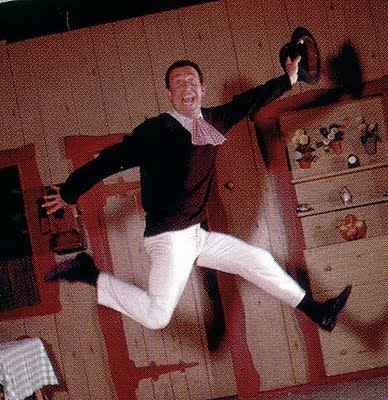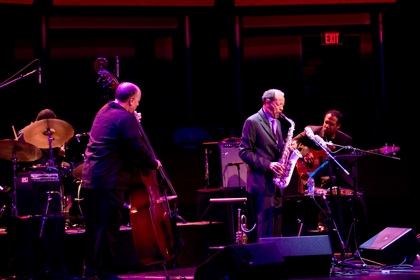Jazz is global, but its most ambitious players still flock to the US to soak in its roots and prove they’re part of the scene. Tonight a Parisian septet called Fractale wraps up an eight-gig tour of the States at the Drom in the East Village, after stops in New Orleans, Cleveland and Chicago. From December 3 to 6 Spanish pianist Chano DomÃnguez & his Flamenco Quintet bring its commissioned “The Flamenco Side of Kind of Blue” to the Jazz Standard to assert that the Barcelona Jazz Festival (in which they premiere the work on November 12) has something to do with the Big Apple. Next February the Portland Jazz Festival explores the theme “Is Jazz Dead (Or Has It Moved To A New Address?).” But incontrovertible evidence suggests that however far the sound has spread, those who matter know where jazz calls home.
Henry Threadgill, seer beyond ‘jazz’
JazzTimes’ robust recovery
The November issue of JazzTimes magazine is the first created (not just published) under the imprimatur of Madavor Media, LLC imprint, and the periodical looks very much the same as before its hiatus last spring. Editors Lee Mergener and Evan Haga remain, columnists Nat Hentoff and Nate Chinen are present, most if not all recent editorial contributors remain on the masthead and features — drumming being the issue’s loose theme — are by regulars, though Fernando González, former editor of rival Jazziz, came onboard to write the story on Guggenheim Foundation and MacArthur fellow Miguel Zenón.
Sweet Rhythm quietly ends run as Village jazz stage
The 7th Ave. home in the ’80s and early ’90s of Gil Evans’ last orchestra, David Murray’s octets, Abdullah Ibrahim’s bands, Lester Bowie’s Brass Fantasy and other avant-gutsy acts closed last night (Oct. 24) without notice or fanfare. Sweet Rhythm nee Sweet Basil was one of the coolest spots to listen, drink and hang out in Greenwich Village, a wood-paneled room with fine sound, sightlines, bookings and bartender, but it never recovered from what its most recent owner described as a post-9/11 decline in street traffic, competition from nearby clubs offering lesser music at no cover charge, and disinterest among the young in jazz.
Soupy Sales, 1926-2009, friend to jazz
The silliest pie-in-the-face TV comic of the ’50s had trumpeter Clifford Brown with drummer Max Roach on his kiddie show. Soupy Sales loved jazz — how cool is that? 
Salsa dura and NYC jazz hot
My new City Arts column cites Chris Washburne‘s SYOTOS band, Arturo O’Farrill and Bobby Sanabria as avatars of Latin American music’s essential excitement, so well depicted by the 4-part PBS documentary “Latin Music USA” (viewable online). But let’s not forget Eddie Palmieri is still in his prime (and coming to the Blue Note jazz club Dec. 9 – 13).
howardmandel.com
Subscribe by Email |
Subscribe by RSS |
Follow on Twitter
All JBJ posts |
Jazz Foundation knows how to party
To raise money for musicians’ health and welfare, how ’bout a jazz party? In three lofts with river views, a thousand attendees of every age, shape, style enjoyed food ‘n’ drink ‘n’ performances including Jimmy Heath playing “Gingerbread Boy,” Arturo O’Farrill‘s teen sons mastering Latin jazz, baritone saxist Hamiet Bluiett with Kahil El’Zabar on mbira. The Jazz Foundation of America kicked out the jams on Sunday night, and raked in donations.
#jazzlives Twitter campaign update, week 7
Raising hands by tweeting that you’ve heard live jazz — write WHO, WHERE and #jazzlives — continues as a phenomenon, almost two months after the campaign began to test if there is an active young audience for the music. Results roll in from far and wide, though solicitations for them have slowed. Musicians are encouraged to tell their audiences to tweet, to spread word of their excellence and ramp up the numbers. A few recent samples follow. . .Â
Miles Ornette Cecil goes Kindle
Huzzah! My book Miles Ornette Cecil — Jazz Beyond Jazz is now an e-book from Amazon for Kindle-reading and maybe other e-book formats, too (I’m checking see below). It’s cheaper than the hardbound version and a long sample including epigrams, Greg Tate’s preface and the start of my first chapter is free. Go through that link above and if you buy I get a $1 kickback as an Amazon Affiliate.
This edition can be optimized for the the larger-screen Kindle DX, though I’m not sure how useful that is. Now I’m psyched to get Future Jazz into an e-book form (I have both paper and hard-bound copies for sale; order an autographed copy, $1 0 and $15 respectively, by leaving a comment below). I’m also interested in if readers of Jazz Beyond Jazz the blog like e-books. Could the e-book, e-article and e-essay be the future of financially compensated music journalism? Opinions solicited — let me know.
update: ebook also available in Mobipocket format.
howardmandel.com
Subscribe by Email |
Subscribe by RSS |
Follow on Twitter
All JBJ posts |
Future of music journalism: It’s about the audience (?)
The dozen “music journalism” professionals at yesterday’s Condition Critical panel of the Future of Music Coalition’s three-day long “policy summit” became somewhat divided (at least from my perspective) over the course of a well-attended hour & three-quarters session. At one end of a spectrum of opinion were the old guard — me, Greg Kot of the Chicago Tribune and Tom Moon, formerly of the Philadelphia Inquirer — asserting that good music journalism puts the music in context, “illuminates, educates and entertains” its readers and reaches beyond its niche to satisfy those who are not devoted yo but may be curious about a given musical topic. At the other was Raymond Leon Roker of URB/URB.com and Todd Roberts, co-founder of the Daily Swarm, who suggested that success in music journalism comes from amplifying, echoing and reinforcing the interests of the largest attractable audience. I may be drawing this too reductively, but it felt like an argument: developing substantive content vs, ever-better marketing, without much interest in content, using the processes of social media.
Everybody’s talking about arts journalism
After last Friday’s summit on new media affecting those who write, read and listen produced by the National Arts Journalism Program/USC Anneberg Center, I’m looking forward to tomorrow’s Future of Music Coalition session “Critical Condition: The Future of Music Journalism.”
Last week in New York beyond jazz

Jazz journalism and the NAJP’s arts journalism summit
The Jazz Journalists Association, of which I’m president, has hope to produce a nationwide conference on media transitions and how currently active professionals cope with them. Today’s National Arts Journalism Program’s summit raises many of the issues and even more questions that challenge my colleagues and I. So I’m going to do some live blogging here, posting a succession of comments while in the lecture hall of Columbia U’s j-school with about a dozen other journalists, watching the summit taking place at the USC Annenberg Center in LA. Here we go, starting with my reaction to the first hour of the summit’s content (the tech’s working pretty well!) Â
